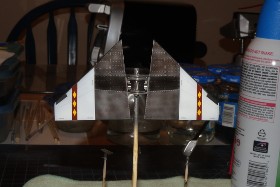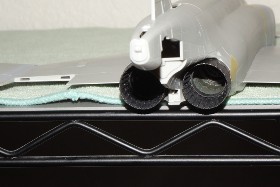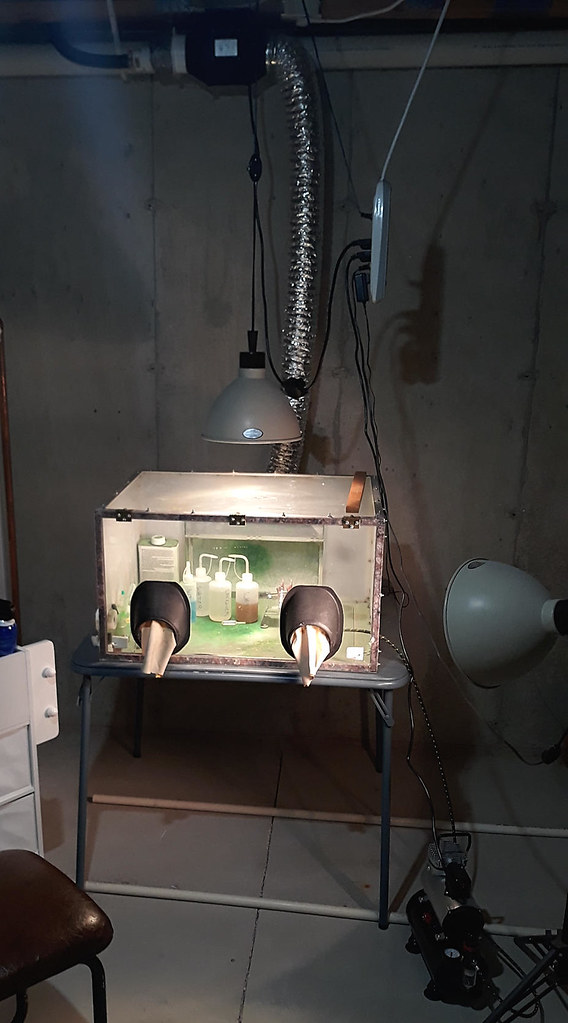Perhaps I am bored. Perhaps I need a diversion from the model I am working on. In either case, here is another post from yours truly. Maybe it will be of interest to someone.
I did some major revamps regarding my spaybooth and the tools that I use with it. I first started by calking some of the air leaks. The blower I am using is one of those portable paint booth jobbers that fold up. I retrofitted it to the back of my booth and what I recently discovered is that the fan housing had some major air leaks. Why is that a problem? Because it is blowing paint particulates and fumes through those leaks and into my working environment. You could litterally feel air blowing out when you put your hand over them. There were three major areas that had leaks.
-
Around the powerswitch housing.
-
Around the flange for the exhaust hose.
-
Around the powercord compartment.
-
Lastly, I shored up the opening into my booth.
Since doing this it has drastically reduced fuming, and I dare say, it improved the air draw out of the booth and through the exhaust hose.
But that is all side commentary of what I wanted to mention. And that is, I have new liquid dispenser bottles, aka, safety wash bottles.
And I have to say, they are proving to be very handy.

I use them primarily for dispensing lacquer thinner during my AB cleaning process. One bottle is for used lacquer, the other is for clean lacquer. So when it’s time to clean the AB, I first squirt thinner from the used thinner bottle and into the color cup. For the most part, particulates settle and what comes out is fairly clean lacquer. (Why waste clean lacquer for this messy stage.) I take a foam swab, dip it into the cup, and wipe the paint from the wall and bottom of the cup. Then I spray the thinner through the brush. I refill the cup but this time leaving the nozzle in the cup, I depress the container, and this causes the thinner to back flush into the bottle. I repeat this process in a quick motion and this forces thinner back and forth helping to loosen remaining paint in the cup. I then spray the thinner into a paper towel and remove the color cup. Using the nozzle I port it up into the neck of the cup, and do the same process of flushing /back flushing. It clears the paint in the neck and bottom of the color cup. And at any stage I can draw the dirty solution back into the bottle. No need to dump it. I reattach the color cup, and now using the fresh thinner bottle I fill the cup and spray out any remaing color. It sounds complicated but it’s easy and fast. Then I follow my regular process of cleaning of the needle and nozzle. Btw. Reusing the dirty lacquer keeps it from having to be dumped. I can use that refuse for probably years.
And if none of that grabs ya, I will just say this. These make for great dispensors. The liquid comes out in a fine and controlled stream. The angle of the nozzles works well with streaming fluid into your cup. I love that the nozzels have caps and that helps with fuming, and with evaporation into your living/working environment.
Also new, are the mini pippets that I ordered. I ordered a box of 200 off Amazon for $9. The waste footprint of these is smaller than the typical pippets, so not as much plastic going into a landfill. And the size is I think perfect for extracting paint from paint jars. I succumbed to using pippets because I was tired of trying to clean the threads off paint jars after pouring. There is less waste of paint too because of this. You can get exact amounts of paint that you need straight from the jar and into your color cup. If you draw too much, squirt it back into the paint jar. No muss, no fuss.
So from all that malarkey, maybe you can garner something. If not, well, I had a good time posting it.
PS: Here are some links.
https://www.amazon.com/dp/B097GYJ4B8?psc=1&ref=ppx_yo2_dt_b_product_details
https://www.amazon.com/dp/B0853DDH7C?psc=1&ref=ppx_yo2_dt_b_product_details






